
History of Mitsubishi Electric Corporation
The history of Mitsubishi Electric is the history of the development of modern Japan. The company was founded in 1921, when Mitsubishi Shipbuilding Co. (now Mitsubishi Heavy Industries, Ltd.) spun off a factory in Kobe, Japan that made electric motors for ocean-going vessels into a new company called Mitsubishi Electric Corporation.
In that year, the new company entered the consumer sector by manufacturing and marketing an electric fan, which became a hit product. Over the next decade the company succeeded in landing major contracts, including one for the development of an electric railway substation.
In the 1930s Mitsubishi Electric started manufacturing, installing and maintaining elevators and escalators as well as producing electric power generation equipment. The company continued to grow and branch out at a brisk pace, and by 1960 had emerged as one of the most innovative diversified electrical equipment manufacturers in Japan. In the early 1960s the company also turned its attention to environmentally conscious manufacturing techniques —many years before environmental concern became a serious issue.
Over the next two decades the company began extending its reach overseas while establishing itself as a pioneer in the development of computers, advanced air conditioning systems, automobile electronics, satellites powered by photovoltaic technology, and nuclear power generation.
From 1980 to the present day, the pace at which Mitsubishi Electric has introduced and refined breakthrough technologies and products for the benefit of society, industry and individuals has been nothing less than astonishing. These technologies include the world's first large-scale LED screen for sports arenas, the world's largest CRT television screen for the consumer market, the world's first spiral escalator, the world's fastest elevators, the antenna technology behind the world's first commercial in-flight Internet service, and much more.
Today, Mitsubishi Electric is a global giant with operations in 40 countries, more than 120,000 employees, and consolidated net sales of more than US$39 billion. (Figures are as per Annual Report 2014.)
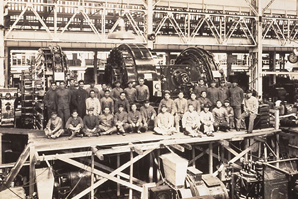
Mitsubishi Electric releases its first electric fan, first television, first elevator and escalator, first computer product and much more...
1970s
- Released a petroleum gas fan heater and FF-type petroleum gas storage hot water supply equipment. (1978)
- Installed elevators which traveled 600 meters per minute, the fastest in the world at that time. (1978)
- Released a futon drier, the RO-1500 range oven, and an electronic heated table (kotatsu) model. (1977)
- Launched the ETS-II engineering test satellite, the first in a series of ETSs for which Mitsubishi Electric was the prime contractor. (1977)
- Produced Japan's largest-capacity nuclear power generator (1,300,000kVA) and a full gas-insulated substation (550kV). (1976)
- Participated in national ultra-LSI R&D project aimed at "Studying Large-Scale Integrated Circuit Technology for the Next Generation of Digital Computers." (1976)
- Introduced a large general-purpose computer, MELCOM COSMO 700. (1974)
- Released the MELSEC310 sequencer. (1972)
- Launched MOLDIS (Mitsubishi Online Distribution Information System) - Japan's first full-scale online realtime distribution information system. (1972)
- Completed the 560,000 kVA turbine generator -- Japan's largest -- for the Kansai Electric Power Company's Mihama Power Plant. (1970)
- Introduced the LOSSNAY heat-exchange ventilation system. (1970)
1960s
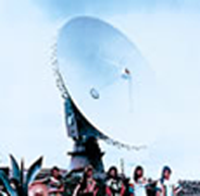
1967
Earth-station antenna
- Released the best-selling MELCOM83 small business computer. (1969)
- Developed the world's first permanent fuse. (1969)
- Chosen as the prime contractor for Japan's first working satellite for ionosphere sounding. (1969)
- Adopted "ADVANCED AND EVER ADVANCING" as our corporate slogan. (1969)
- Released a wall-mounted split-system room air conditioner featuring a line flow fan. (1968)
- Completed the first Mitsubishi nuclear power generator (400,000kVA). (1968)
- Delivered an earth-station antenna to the Mexican Ministry of Communication for use with an international satellite. (1967)
- Began technological cooperation on space technology with America's TRW. (1966)
- Manufactured a commercial CVCF inverter and developed a VVVF inverter. (1965)
- Supplied radar equipment to the weather station atop Mt. Fuji. (1964)
- Delivered 1650 kVA main transformer and 185 kW electric motor for use in the Shinkansen (Bullet Train). (1963)
- Delivered Japan's first subway train with an automatic train-operation (ATO) system. (1962)
- Released Japan's first IC chip: the Molectron. (1961)
- Produced the first Mitsubishi color TV, incorporating technology developed by RCA Corp. (1960)
- Launched Mitsubishi Electric's initial computer entry, MELCOM 1101. (1960)
1960s
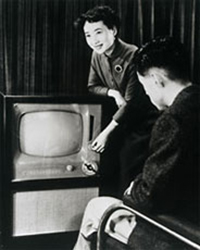
The first Mitsubishi Electric
television (Model 101K-17),
launched in 1953.
- Completed the first Mitsubishi electrical-discharge machine. (1958)
- Completed 105,000 kVA Francis-type hydraulic turbine generator for the J-Power Tagokura power plant, featuring umbrella-type construction with Japan's highest generation capacity. (1957)
- Completed the ITV - Japan's first ever industrial use television. (1954)
- Released the first Mitsubishi Electric television (Model 101K-17). (1953)
- Completed Japan's first DD50 diesel-electric locomotive, for the Japan National Railways. (1953)
- Began semiconductor research. (1952)
- Succeeded in making Japan's first V-type oil circuit breakers for use on ultra high-voltage lines (287.5kV/5,000MVA). (1951)
1940s
- Commenced production of radios and speakers. (1945)
1930s
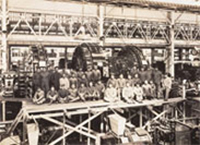
Factory in the 1930s.
Commemorating the completion of
Japan's largest (at the time) motor
with an output of 9000 hp.
- Installed the first Mitsubishi electric power generation equipment. (1938)
- Listed on the Tokyo Stock Exchange. (1937)
- Delivered the first Mitsubishi elevator. (1935)
- Delivered the first Mitsubishi escalator. (1935)
- Marketed no-fuse breakers, the first domestically produced fuseless circuit breakers (15-35 amperes). (1933)
1920s
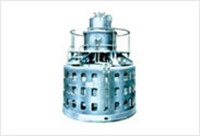
1924 Vertical-axle hydraulic
generator

1921-23 Electric fan
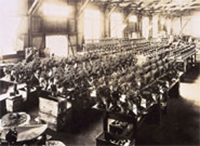
Mitsubishi Electric's first mass-
produced consumer product.
Mitsubishi Electric's technical
expertise in heavy electric systems
was applied to manufacture
products for the home.
- Installed the first Mitsubishi electric power generation equipment. (1938)
- Listed on the Tokyo Stock Exchange. (1937)
- Delivered the first Mitsubishi elevator. (1935)
- Delivered the first Mitsubishi escalator. (1935)
- Marketed no-fuse breakers, the first domestically produced fuseless circuit breakers (15-35 amperes). (1933)

Installed the first ever Diamond Vision screen; the world's first spiral escalator; mass production of high-output semiconductor lasers; listing on the London and Paris stock exchanges, and much more...
1989s
- Released the MELCOM80 small business computer with Greo.
- Optical neurocomputer successfully recognized the 26 letters of the alphabet.
- Listed on the London and Paris stock exchanges.
- Implemented automated production and CIM for ventilation fan motors.
- Developed and began mass-production of super current limiting breakers.
- Developed an electronic-device cleaning process using ultra-fine ice particles.
- Achieved sales in excess of 2 trillion yen (2,230.1 billion yen for fiscal 1989).
1988s

1988 Spiral escalator
- Installed spiral escalators in a shopping center in San Francisco.
- Developed and implemented an elevator control system that uses AI/fuzzy logic.
- Developed a prototype optical neurochip, paving the way for the development of an optical neurocomputer.
- Developed a low-power digitized hydraulic elevator featuring pressure-compensated controls.
- Began running the Mitsubishi Electric "MIND" VAN.
1987s
- Released the MELDAS 300 series, the world's first 32-bit CNC.
- Released the MELCOM EX860, 870 and 880 mainframe computers.
- Released the cluster ion beam unit, which is effective in forming superconducting membranes.
- Developed a 4 MB DRAM chip small enough to fit on a 300 mil wide DIP.
1986s
- Released the ML806T2 carbon-dioxide gas laser processing machine.
- Released the MELMUX network-type high-speed digital multiplexer.
- Produced the world's first sequential inference machine, MELCOM PSI.
- Introduced a cordless car telephone.
- Developed a compact cassette-type high-definition VCR.
- Began mass production of 1Mbit DRAMs, and successfully developed and test-manufactured 4Mbit DRAMs.
1985s

1985
35-inch color television
- Released the MIBASS intelligent building system.
- Released a 37-inch color TV.
- Received order as the prime contractor for FUYO-1 (JERS-1), the first large-scale Earth resources satellite manufactured in Japan.
- Produced a working videoconferencing system using a vector quantization.
- Began sales of the "Super Scrum" series circuit breakers.
1984s
- Produced the spiral escalator.
- Mass-produced high-output semiconductor lasers, on a par with the highest world standards, for use in optical communications.
1983s
- Released a color TV with a built-in TV printer.
- Produced a working version of a microwave-discharge light-emitting device.
- Named the prime contractor for the nation's first domestically produced communications satellite, CS-3.
- Began mass production of 256K DRAMs and developed a 1Mbit DRAM.
1982s
- Produced an optical pickup for use in compact disc players.
- Developed a 50 kW phosphoric acid fuel cell.
1981s
- Produced the ML-1000P carbon-dioxide gas laser oscillator.
1980s
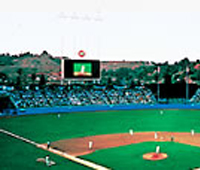
1980 Diamond Vision
- Supplied Japan's first 45m-diameter radio telescope, to Tokyo Planetarium.
- Delivered the first Diamond Vision mammoth outdoor color video-display system, to Dodger Stadium in Los Angeles.
- Achieved sales in excess of 1 trillion yen (1,075.4 billion yen for fiscal 1979).

Tie-ups with IBM and Hewlett-Packard; establishing philanthropic foundations in the USA and Thailand; awards from the U.S. Environmental Protection Agency; the first recycling plant for the household appliance industry, and more...
1999s
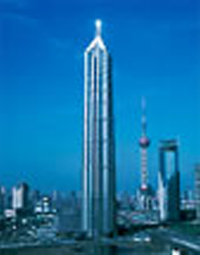
1999 Jin Mao Building
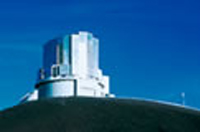
1999 Subaru Telescope
- Subaru Telescope of the National Astronomical Observatory Japan, which utilizes the company's actuator technologies, is delivered and installed on Mauna Kea, Hawaii Island, Hawaii, USA.
- Fastest elevators in China (540m/min) delivered to the Jin Mao Building in Shanghai China, the second tallest building in the world.
- Established TMA Electric Corp. a joint venture with Toshiba Corporation for the development and manufacture of high-capacity electric motors.
- Completed and commenced operations at the Higashihama Recycling Center, the first recycling plant for the household appliance industry.
1998s
- Introduced practical use of CMOS image sensor technology.
- Agreement made with Matsushita Electric and Matsushita Electronics for joint development of next-generation system LSI.
1997s
- Started mass production of the world's first CMOS image sensor.
- Developed the Bedside Wellness System.
- Commenced sales of the ultra-thin mobile computer, Pedion.
- Awarded "Best-of-the-Best" prize by the U.S. Environmental Protection Agency in recognition of outstanding contributions to environmental protection.
1996s
- Introduced practical use of CMOS image sensor technology.
- Agreement made with Matsushita Electric and Matsushita Electronics for joint development of next-generation system LSI.
1995s
- Integrated overseas and domestic business divisions in response to globalization.
- Estabilished research center in Europe.
1994s

1994 Kansai Airport
- Released the world's first energy-saving household air conditioner.
- Received the 1994 Stratospheric Ozone Protection Award from the U.S. Environmental Protection Agency.
- Installed a Doppler radar system and other airport-related equipment at Japan's New Kansai International Airport.
- Drafted "Vision 21," a project targeting new business development from Mitsubishi Electric's perspective of society in the year 2010.
- Developed ultra-fine pattern forming technology using X-ray lithography.
1993s
- Released the "Chilled" refrigerator in response to the CFC controls introduced in 1996.
- Reductions in the use of special chlorofluorocarbons.
- Installed the world's fastest passenger elevator at the time (750m/min), in the Landmark Tower Yokohama.
- Delivered the Heavy Ion Medical Accelerator (HIMAC) to the National Institute of Radiological Sciences.
1992s
- Successfully developed an artificial retina chip.
- Estabilished the SOCIO-ROOTS Fund.
- Developed a CMOS image sensor.
1991s
- Strengthened foothold in the computer business through tie-ups with IBM and Hewlett-Packard.
- Established the Mitsubishi Electric Thailand Foundation.
- Developed and implemented a high-definition full-color sublimation printer for CAD applications.
- Commenced trial production of 64Mbit DRAMs.
- Activities to boost U.S. community contributions begun at Mitsubishi Electric America Foundation.
1990s
- Released the "Scene" range of light fixtures designed for lifestyle scenarios.
- Released successive domestic appliances and other products incorporating fuzzy logic.
- Released a die-sinking electrodischarge machine featuring fuzzy logic-based control.
- Purchased the hardware division of the British firm Apricot Computers.

KASUMI selected as the standard encryption code for GSM mobile telephones; launch of MTSAT-2 and Superbird-7; released the world's first non-contact fingerprint recognition device; adopted "Diamond Vision Solutions," and more...
2009s
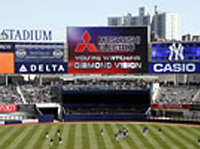
Photo courtesy of New York
Yankees
- Received order to supply Proximity Link System (PLS) to guide Cygnus Spacecraft to the International Space Station (ISS) on re-supply missions for the National Aeronautics and Space Administration (NASA).
- "DIAMOND VISION SOLUTIONS" adopted as collective brand name for Mitsubishi Electric Group's visual solutions business.
- Diamond Vision screen installed at the Dallas Cowboys Stadium is recognized by Guinness World Records as the world's largest high-definition display. The recognized screen measures 22m high by 48m wide.
- Developed the world's first hybrid nano coating that can be applied to materials ranging from metals to plastics for protection against dust, oil and other substances.
- Received order from Japan Meteorological Agency (JMA) to build the meteorological satellites HIMAWARI 8 and 9.
- Delivered Major League Baseball's first full 1080 x 1920 high-definition LED, 16mm pixel pitch Diamond Vision Screen to Yankee Stadium in New York.
-
Released the NJ-XS10J, the world's first* steamless IH (induction heater) rice cooker with no steam port.
* Feb 1, 2009. Based on water-cooling steam recovery system. (Mitsubishi Electric research).
2008s

- Became the first Japanese manufacturer to enter the commercial communications satellite market outside of Japan with the introduction of an original satellite bus, and has received an order from Singapore and Taiwan to build the ST-2 as their next communications satellite.
- Announced growth strategies and reinforced/expanded global warming countermeasures for reducing CO2 through business activities, toward achieving harmony between fulfilling lifestyles and global environmental preservation, as laid out in "Environmental Vision 2021."
- Succeeded in launching Superbird-C2 (7), the first domestic commercial communications satellite made in Japan for Space Communications Corporation, and completed the handover of the satellite to Sky Perfect JSAT Corporation on October 17, after completion of in-orbit performance testing.
- Two persons from Mitsubishi Electric awarded the Purple Ribbon Medal for development of large-scale optical telescope mirror support system for use on the Subaru telescope.
- Received an order to install four Diamond Vision displays and three LEDerAd ribbon board displays in the new stadium being built for the NFL Dallas Cowboys (scheduled to open in June 2009).
- Achieved the world's highest energy conversion rate of 18.6% in a polycrystalline silicon photovoltaic cell.
- Installed Asia's longest Aurora Ribbon, a very long LEDerAd ribbon board display, at the Chiba Marines baseball stadium in Japan.
2007s
- Succeeded in verification experiments on the world's longest 80km key distribution with a cryptography system using a single photon source, jointly with Hokkaido University and other institutions.
- Awarded the Prime Minister's Prize at the 36th Japan Industrial Technology Awards for the short-gap high-density ozone generator.
- Awarded the Japan Institute of Invention and Innovation Chairman's Prize at the FY2007 National Commendation for Invention Awards, for inventing the technology of using existing refrigerant piping for new air conditioning units for cooling.
- Achieved the world's highest photoelectric conversion efficiency of 18.0% in practical-use multi-crystalline solar cells.
- Completed construction of the world's tallest elevator testing tower, measuring 173m, at Inazawa Works.
- Delivered Japan's largest security system, which monitors document access using IC tags, to the Bank of Tokyo-Mitsubishi UFJ.
- Announced Environmental Vision 2021--Making Positive Contributions to the Earth and its People through Technology and Action.
2006s
- Successfully launched the MTSAT-2 multifunctional transport satellite.
- Awarded the 21st Century Invention Prize at the FY2006 National Commendation for Invention Awards for inventions related to high-efficiency high-density ozone generating technology.
- Installed the Multi-screen Turf Vision (Aurora Vision), the world's largest display, at the JRA Tokyo Racetrack.
- Successfully launched Hinode, a solar observatory satellite for which Mitsubishi Electric was a prime contractor.
2005s
- The Mitsubishi Diamond Vision screen at the Turner Field baseball stadium in the U.S.A. is recognized as the world's largest outdoor HDTV video screen.
- The "Camellia" next-generation encryption algorithm jointly developed with NTT is adopted as the next-generation encryption standard for the Internet.
- Started development of the "Uni & Eco" brand concept for household appliances with the aim of making products that are easy to use and which have low environmental impact.
- Released the Mitsubishi Finger Identification Device by Penetrated Light, the world's first non-contact fingerprint recognition device.
- Produced the 40 millionth ventilation fan at the Nakatsugawa Works.
- Became the first company in the world to receive approval to manufacture particle-beam treatment devices that use carbon ions.
2004s

2004 Reversible LCD
- Successfully acquired ISO14001 certification for all Mitsubishi Electric offices, including head offices and branches.
- Released the world's first refrigerator that "increases vitamin C content."
- Presented the Best Supplier Award by The Boeing Company.
- Developed the world's first LCD module, "Reversible LCD," capable of being viewed from both sides.
- Developed Japan's first variable-speed elevator system, shortening wait times by up to 15%.
- Constructed a system for producing 5 million red semiconductor lasers per month for use with recordable DVDs.
- Awarded the "Imperial Invention" prize at the National Invention Awards for work in the field of safe and powerful encryption technology.
2003s

2003 Sha Tin Racecourse
- Successfully launched "OPTUS-1," the first overseas commercial satellite for which Mitsubishi Electric was a prime contractor.
- Renesas Technology founded as a semiconductor joint venture with Hitachi Ltd.
- Received an order from the New York City Transit Authority to supply air conditioning units for 660 subway cars.
- Jointly developed a revolutionary coating technology that uses electrical discharges (Micro Spark Coating) with Ishikawajima-Harima Heavy Industries.
- Developed the world's widest "Diamond Vision" display for operation at the Sha Tin Racecourse in Hong Kong.
- Developed the world's first 50-ampre-compliant large-capacity DIP-IPM.
- Developed the world's first "finger composition characteristics detection" optical fingerprint sensor.
- Achieved the world's first transmission at 10Gbps between relay equipment boards set at a distance of 500mm apart.
- Achieved the world's first interconnection between GMPLS that realizes next-generation photonic networks and MPLS that offers highly advanced IP services.
2002s
- KASUMI selected as the standard encryption code for GSM mobile telephones.
- In cooperation with NHK, developed the world's first digital watermarking equipment.
- First in the world to successfully prove second-generation X-ray lithography technology.
- Developed the world's highest output red LED for DVD read and read/write applications.
- Developed the world's first 40Gbps semiconductor light modulator and module.
- Began working relationship with VeriSign Japan to supply digital signature solutions.
2001s

2001 Artificial retina LSI
- Successfully developed the world's first system for directly extracting dioxins contained in incinerator flue gases.
- Signed a contract with America's General Motors as a long-term supplier of ignition coils.
- Molecular design technology applied for the first time ever to develop a new insulating film for use in next-generation high-speed ULSIs.
- Installed the world's first large-scale outdoor HDTV screen on the Studio Alta building at Shinjuku in Tokyo.
- Enactment of Mitsubishi Electric's "Changes for the Better" corporate statement.
- Developed the world's smallest, lowest energy consuming "single-chip encoder" for MPEG-2 video and audio system integration.
- Developed the world's highest light-collecting efficiency rating for a completely solid 1kW-class pulse laser.
- Developed the world's first portrait generation technology for mobile devices that use artificial retina LSIs.
- Developed CMOS technology that realizes both high reliability and high performance for system-on-chip devices.
- Completed construction of the FA R&D Center.
2000s
- Successfully tested Japan's first quantum cryptographic communications system.
- Mitsubishi Electric & Electronics USA, Inc. received Helen Keller Achievement Award 2000.
- Higashihama Recycling Center received Wastec Award (Environmental Agency Director's Award).
- Formed business tie-up with Schindler Holding Ltd. for elevators and escalators.
- Established NEC-Mitsubishi Electric Visual Systems Corp. a joint venture on equal footing with NEC Corporation for the production of display monitors.
- Developed the world's first photoresist stripping unit for LCD fabrication that uses highly concentrated ozone.
- Began licensing Kasumi, an international standard encryption method for W-CDMA.

Developed elevator energy conservation management system; the world's largest and longest Diamond Vision screen...
2016s
- Established a new company in Turkey for room air conditioner development and manufacture, named Mitsubishi Electric Turkey Klima Sistemleri Üretim Anonim Şirketi (Mitsubishi Electric Air Conditioning Systems Manufacturing Turkey). Slated to begin production in January 2018.
- Founded Dynamic Map Planning Co., Ltd.
- Received the Prize of the Chairman of HATSUMEI KYOKAI (JIII) in the FY2017 National Invention Awards for the design of the VP-X high-efficiency turbine generator.
- Announced a corporate donation of 50 million yen (approximately US$440,000) and a separate donation worth a cumulative amount of approximately 63 million yen (approximately US$560,000) through an in-house matching gift program – the Mitsubishi Electric SOCIO-ROOTS Fund – for restoration of damage from the 2016 Kumamoto Earthquake.
- Received an order from Transport for New South Wales (TfNSW) to supply 512 passenger cars' worth of railway systems to the New Intercity Fleet in Australia.
- Selected among the Good Design Best 100 in the FY2017 Good Design Award for the "Kirigamine FL series" room air-conditioners and the Segment-Handling Robot for Next-Generation Thirty Meter Telescope (TMT®).
- Named by the international NGO CDP as a Water 2016 A List company, the highest rank of the index, for its recent water management initiatives to help preserve the natural environment.
-
Delivered the world's fastest elevator*, the world's tallest elevator*, and the world's fastest double-deck elevator* to Shanghai Tower, the tallest building in China (632m high).
* Among elevators in operation as of December 8, 2016
2015s
- Established an MEU (Mitsubishi Electric Europe) South Africa Branch Office in Johannesburg, South Africa. Operations commenced on June 1.
- Received an order to install Diamond Vision screens at QVC Marine Field in Chiba, Japan for use beginning in March 2016 (total of 5 screens: 1 main screen, 2 left and right field sub-screens, and 2 infield sub-screens).
- Acquired shares of the Italian industrial air-conditioner company DeLclima S.p.A (acquisition of the company as a subsidiary).
- Opened the Mitsubishi Electric Event Space "METoA Ginza."
- Developed the EMIRAI3 xDAS concept car featuring driving-assistance technology and the EMIRAI3 xAUTO concept car featuring preventive safety technology (autonomous driving technology).
- Succeeded in launching Turkey's communications satellite Turksat-4B.
- Developed the world's first voice-activated drawing function that displays spoken words where a finger is traced on the screen.
- Mitsubishi Electric is appointed as an official partner of the Tokyo 2020 Olympic and Paralympic Games.
- Received an order worth approx. 1.7 billion yen from Siemens AG in Germany for the delivery of 328 railcar air-conditioner units for use in the new railcars of the Rhein-Ruhr Express train (82-car train sets totaling 164 cars).
2014s
- Completed the development of and launched the Advanced Land Observing Satellite-2 (ALOS-2, or commonly called Daichi-2), a project which Mitsubishi Electric undertook as the main contractor for JAXA (Japan Aerospace Exploration Agency).
- Completed the manufacture of and launched geostationary meteorological satellite Himawari-8, contracted by the Japan Meteorological Agency.
- Received an order to deliver communications satellite Es'hail 2 to Es'hailSat, a state-run satellite communications company in Qatar.
- Received an order from Saga Heavy Ion Medical Accelerator in Tosu (Saga Himat) to deliver the Pencil Beam Scanning system, which can more accurately and efficiently irradiate affected areas with heavy particle beams.
- Received an order from railway operator Deutsche Bahn AG to deliver a railcar electrical device (propulsion control device) for Intercity-Express 2 (ICE-2) high-speed trains, as the first Japanese manufacturer to do so, for a total price of approximately 3 billion yen.
- Installed a 4K full ultra-high-definition video display measuring over 100m in total width to the exterior wall of Marriott Marquis Hotel in Times Square, New York, as the world's largest display for a commercial facility.
- Developed an advanced manufacturing technology for boron-carbide diaphragms used in hi-fi loudspeakers, which realizes the world's fastest sound propagation speed by combining the use of new manufacturing technology and acoustic analysis technology.
- Installed a total of three Diamond Vision displays to Sapporo Dome, including two large units offering the highest resolutions among all 12 stadiums in Japanese professional baseball (4,000 (w) × 1,080 (h)) and one infield scoreboard (1,640 (w) × 480 (h)).
- Delivered a total of 51 elevators and escalators to Shanghai New World Daimaru Department Store—a large commercial facility located in Shanghai, China—including 12 spiral escalators, the largest order for a single project.
- elivered land terminal equipment for the project to upgrade the SEA-ME-WE4 cable system to 100Gbps and enhance the 20,000km fiber-optic cable system that connects Southeast Asia, the Middle East, and Western Europe.
2013s
- Successfully launched communications satellite "Turksat-4A," the contract for which was awarded by Turkey's national satellite operator, Turksat. Subsequently, the delivery of the satellite was completed in orbit.
- Announced that the red three-diamond corporate logo used overseas would now be used within Japan as well. (Previously, Mitsubishi Electric companies in Japan had been using a separate blue logo.)
- Received orders from Tsuyama Jifukai Group’s Tsuyama Chuo Hospital and from the Hakuhokai Group to provide our new proton beam therapy system for cancer treatment. These will be the first particle therapy systems for cancer to be installed in the Chugoku-Shikoku region and Osaka Prefecture.
- Developed the world's first Super Hi-Vision (8K) HEVC encoding device in collaboration with Japan Broadcasting Corporation (NHK).
- Installed two high-definition Diamond Vision displays in Reliant Stadium in Texas, home of the Houston Texans American football team, which garnered attention as the largest such displays in any sports facility in North America.
- Received orders to deliver a total of 38 elevators and escalators to the "tallest-to-be" commercial complex under construction in Bangkok, Thailand (314m; 77 floors above ground, 1 floor below ground) including 7 elevators that will travel at a speed of 480m/min and are expected to be the fastest elevators in Thailand.
- Released the lightweight and compact "Fujin" cyclone vacuum cleaner, which delivers sustained suction (more than 99%) and clean air exhaust (final collection rate 99.999%), as a commemorative model for the 80th anniversary of Mitsubishi Electric's development of vacuum cleaners.
- Completed expansion of the satellite production facility at the company's Kamakura Works in Kamakura, Japan. The upgraded facility doubles Mitsubishi Electric's annual satellite production capacity to eight satellites, the largest among all facilities operated by Japanese satellite manufacturers.
- Delivered world's first SiC auxiliary power supply systems for railcars.
- Installed 34 elevators and 18 escalators in the Ginza Kabukiza (Chuo ward, Tokyo).
- Delivered the world's first helicopter satellite communication system (HSA40) to Japan's Fire and Disaster Management Agency (FDMA).
2012s
- Delivered multi-screen SNB (super narrow bezel) displays, Diamond Vision, and other digital signage displays for use in the Tokyo Station Marunouchi Building of East Japan Railway Company.
- Integrated the lighting business under Mitsubishi Electric Lighting Co., Ltd., and launched a new brand named "MILIE" to promote LED lighting.
- Developed a plastic recycling technology that can instantaneously separate plastic waste that has been sorted and recovered from recycled home appliances at a high material purity of over 99%, in a joint effort with Shimadzu Corporation.
- Developed automatic dismantling equipment to recover rare earth magnets from used room air conditioners, and commenced rare earth magnet recovery operations at Green Cycle Systems Corporation.
- Installed a PV-EV Linked Inverter for linked control of high-capacity power storage batteries for applications such as photovoltaic power generation (PV) and electric vehicles (EV) in the Ofuna Smart House (in the Information Technology R&D Center), creating the industry's first PV-EV Linked HEMS
- Completed construction and commenced operation of a video monitoring system production facility at the Koriyama Factory (Koriyama, Fukushima Prefecture), Communication Networks Center, which had been damaged in the Great East Japan Earthquake
- Delivered Japan's largest digital signage system, comprising 100 display units featuring a total of 336 display screens, including a large-screen organic EL "Panorama Vision" screen, to Narita International Airport Corporation
- Launched "Smart Quality" as a new total concept for our Home Appliances Division
2011s

- Mitsubishi Electric Group contributed 500 million yen to support relief efforts in the wake of the Great East Japan Earthquake. It also matched employees' donations collected through the Mitsubishi Electric SOCIO-ROOTS Fund and contributed a combined total of approximately 290 million yen to aid survivors and orphans from the earthquake disaster.
- Celebrated Mitsubishi Electric's 90th anniversary. Looking towards its 100th anniversary, the company will aim to become a global, leading environmental company, contributing to society through technology.
- Received a contract from the TAT-14 CN Purchasing Consortium to upgrade the consortium's submarine optical cable system, TAT-14 Cable Network, to 40Gbps. The upgrade of a transatlantic cable to 40 Gbps is the world's first.
- Delivered OLED panels that can display images with ten times higher resolution than conventional LED panels, to the 6-meter-diameter Geo-Cosmos Globe displayed at the National Museum of Emerging Science and Innovation as its symbol exhibit.
- Received an order to deliver 106 elevators, including three that would boast the world's fastest speed of 1,080m/min, to Shanghai Tower, a skyscraper under construction in Shanghai, China (height: 632m; slated for completion in 2014).
- Commenced full-scale operations of the Smart Grid and Smart Community demonstration facilities in Amagasaki and Wakayama.
- Mitsubishi Electric's Diamond Vision large-scale display received the 63rd Annual Technology & Engineering Emmy Award from the National Academy of Television Arts & Sciences.
- Developed the industry's smallest EV motor system with built-in SiC inverter, in which all power chips in the motor's inverter are SiC-based.
2010s
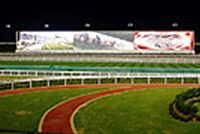
- Received order for carbon ion particle therapy system from SAGA HIMAT Foundation* (Tosu-shi, Saga Prefecture, Japan).
* Public Interest Incorporated Foundation - Launched "RakuRaku-UD," a set of assistance features on home appliance products that make it easier to use the products' various advanced functions.
- Received order from Spanish railcar manufacturer Construcciones y Auxiliar de Ferrocarriles, S.A. (CAF) for electric equipment to be used in railcars on Sao Paulo Metropolitan Train Company's Line 8, in Brazil.
- Began Japan's first large-scale, high-purity plastic recycling, using technology that automatically separates at high purity the three main plastics out of shredded mixed plastic recovered from end-of-life home appliances. These activities were started at Green Cycle Systems Corporation, a Mitsubishi Electric subsidiary.
- Developed an elevator energy conservation management system that can reduce overall elevator power consumption by up to 10 percent.
- Sojitz Corporation and Mitsubishi Electric Corporation install the world's largest and longest (107.52m wide x 10.88m high) Diamond Vision screen at Dubai's Meydan Racecourse. Screen area: 1,169.8m².